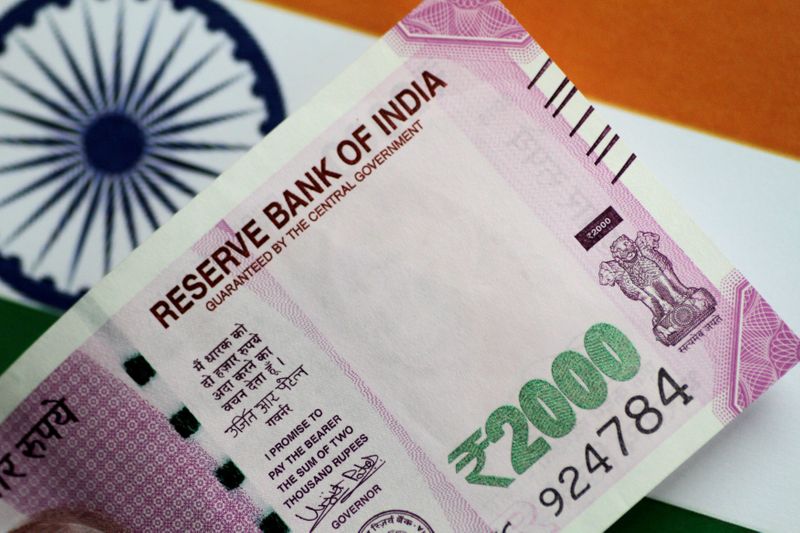
[ad_1]

© Reuters. FILE PHOTO: An India Rupee note is seen in this illustration photo June 1, 2017. REUTERS/Thomas White/Illustration
By Sameer Manekar
(Reuters) – Investors trimmed bearish bets on most Asian currencies as the dollar weakened on hopes of a temporary pushback in the Federal Reserve’s tapering timeline, while sentiment on the Indian rupee turned marginally bullish, a Reuters poll showed on Thursday.
Investors unwound their bearish bets on the Indian rupee to be slightly bullish for the first time since mid-June, with the currency appreciating 0.2% in August after vaccination programs were ramped up and the central bank continued its monetary policy support.
Economic growth in India is expected to touch a record high in the June-quarter on the back of very weak base last year and a rebound in consumer spending, despite the drag from the deadly second virus wave, another Reuters poll showed.
Elsewhere, short bets were largely trimmed on the Malaysian ringgit, the Philippine peso, and the Thai baht, the poll of 10 respondents on Asian currencies showed.
The U.S. dollar has eased 0.4% over the last two weeks and has slipped from a 9-month high as positive economic data and easing worries about the impact of the Delta variant has kept the Fed away from dialling back its monetary stimulus. [USD/]
Bearish bets on the Malaysian ringgit were at their lowest since mid-July, as the currency appreciated over 1% in the past two weeks after a new Prime Minister took an oath. It ended a brief period of political uncertainty that had rattled the markets.
Short bets on the baht were at their lowest since July, even as the currency weakened more than 9% and is the worst-performing unit in the region so far this year.
However, worries surrounding rising infections in the region have increased, with South Korea, India, and Thailand experiencing pressures on their vaccinations, and China witnessing new outbreaks recently.
Meanwhile, investors slightly raised their short bets on the Chinese yuan in the last two weeks as the latest virus outbreak continues to pressure economic activity.
South Korean won’s bearish bets ticked higher as the currency hit its lowest since September 2020 earlier this month, pressured by offloading of stocks by foreign investors and surging cases.
On the Taiwanese dollar, investors turned bearish once again after being marginally bullish two weeks ago.
The Reuters survey is focused on what analysts believe are the current market positions in nine Asian emerging market currencies: the Chinese yuan, South Korean won, Singapore dollar, Indonesian rupiah, Taiwan dollar, Indian rupee, Philippine peso, Malaysian ringgit and the Thai baht.
The poll uses estimates of net long or short positions on a scale of minus 3 to plus 3.
A score of plus 3 indicates the market is significantly long U.S. dollars. The figures included positions held through non-deliverable forwards (NDFs).
The survey findings ASIAPOSN are provided below (positions in U.S. dollar versus each currency):
DATE
26/08 0.425 0.868 0.474 0.18 0.326 -0.08 1.1922 0.779 1.351
12/08 0.32 0.69 0.77 0.2 -0.09 0.37 1.39 1.17 1.75
29/07 0.27 0.78 0.71 0.27 0.36 0.29 1.4 1.21 1.49
15/07 -0.15 0.27 0.53 0.23 0.13 0.68 1.06 1.06 1.56
01/07 -0.29 -0.29 0.02 0.36 -0.19 0.5 0.49 -0.04 0.85
17/06 -0.63 -0.36 -0.49 -0.5 -0.58 -0.21 -0.05 -0.31 0.2
03/06 -1.34 -0.51 -0.55 -0.4 -0.44 -0.71 0.32 -0.66 0.37
20/05 -0.33 0.43 0.37 -0.06 0.33 -0.03 0.26 -0.22 0.81
06/05 -0.52 -0.39 -0.58 0.31 -0.59 0.86 -0.04 -0.35 0.5
22/04 -0.17 -0.23 -0.44 0.56 -0.38 0.75 -0.03 -0.37 0.58
[ad_2]
Source link